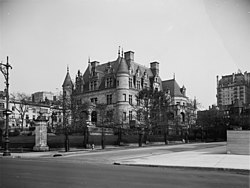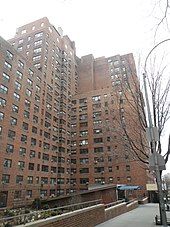
The Bethlehem Steel Corporation was an American steelmaking company headquartered in Bethlehem, Pennsylvania. Until its closure in 2003, it was one of the world's largest steel-producing and shipbuilding companies. At the height of its success and productivity, the company was a symbol of American manufacturing leadership in the world, and its decline and ultimate liquidation in the late 20th century is similarly cited as an example of America's diminished manufacturing leadership. From its founding in 1857 through its 2003 dissolution, Bethlehem Steel's headquarters and primary steel mill manufacturing facilities were based in Bethlehem, Pennsylvania, in the Lehigh Valley region of the United States.

Henry Clay Frick was an American industrialist, financier, and art patron. He founded the H. C. Frick & Company coke manufacturing company, was chairman of the Carnegie Steel Company and played a major role in the formation of the giant U.S. Steel manufacturing concern. He had extensive real estate holdings in Pittsburgh and throughout the state of Pennsylvania. He later built the historic Neoclassical Frick Mansion, and upon his death donated his extensive collection of old master paintings and fine furniture to create the celebrated Frick Collection and art museum. However, as a founding member of the South Fork Fishing and Hunting Club, he was also in large part responsible for the alterations to the South Fork Dam that caused its failure, leading to the catastrophic Johnstown Flood. His vehement opposition to unions also caused violent conflict, most notably in the Homestead Strike.

Charles Michael Schwab was an American steel magnate. Under his leadership, Bethlehem Steel became the second-largest steel maker in the United States, and one of the most important heavy manufacturers in the world.

Riverside Drive is a scenic north–south thoroughfare in the New York City borough of Manhattan. The road runs on the Upper West Side of Manhattan, generally paralleling the Hudson River and Riverside Park between 72nd Street and the vicinity of the George Washington Bridge at 181st Street. North of 96th Street, Riverside Drive is a wide divided boulevard. At several locations, a serpentine local street diverges from the main road, providing access to the residential buildings. Some of the city's most coveted addresses are located along its route.

Gracie Mansion is the official residence of the mayor of New York City. Built in 1799, it is located in Carl Schurz Park, at East End Avenue and 88th Street in the Yorkville neighborhood of Manhattan. The Federal-style mansion overlooks Hell Gate channel in the East River and consists of two sections: the original two-story house and an annex built in 1966. The original house is a New York City designated landmark and is listed on the National Register of Historic Places.

The Pittsburgh Center for the Arts (PCA) is a non-profit community arts campus that offers arts education programs and contemporary art exhibitions in Pittsburgh, Pennsylvania, United States.

Titus de Bobula (1878–1961) was a Hungarian-American architect.

George A. Fuller was an American architect often credited as being the "inventor" of modern skyscrapers and the modern contracting system.
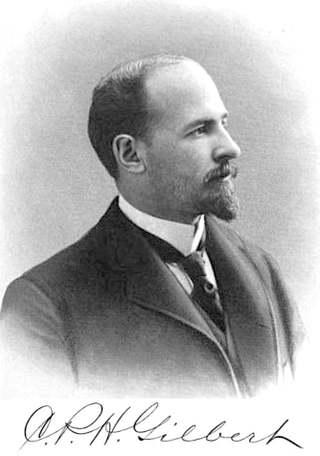
Charles Pierrepont Henry Gilbert was an American architect of the late-19th and early-20th centuries best known for designing townhouses and mansions.

Taylor Stadium was a stadium in Bethlehem, Pennsylvania that hosted the Lehigh University Engineers football team until 1988, when the team moved to Goodman Stadium in Bethlehem.

930 Fifth Avenue is a luxury apartment building on Fifth Avenue on the northeast corner of East 74th Street in the Upper East Side of Manhattan, New York City. The eighteen-story structure and penthouse was designed by noted architect Emery Roth and built in 1940. According to architecture critic Paul Goldberger, 930 and 875 Fifth Avenue show Roth in transition from historicist to modern Art Deco style.

The William A. Clark House, nicknamed "Clark's Folly", was a mansion located at 962 Fifth Avenue on the northeast corner of its intersection with East 77th Street on the Upper East Side of Manhattan, New York City. It was demolished in 1927 and replaced with a luxury apartment building.

The Henry T. Sloane House is a mansion located at 9 East 72nd Street on the Upper East Side of the borough of Manhattan, New York City. It was designed by Carrère and Hastings in the late Rococo style and built in 1894.

The Felix M. Warburg House is a mansion located at 1109 Fifth Avenue, on the Upper East Side of Manhattan in New York City. The house was built from 1907 to 1908 for the German-American Jewish financier Felix M. Warburg and his family. After Warburg's death in 1937, his widow sold the mansion to a real estate developer. When plans to replace the mansion with luxury apartments fell through ownership of the house reverted to the Warburgs, who then donated it in 1944 to the Jewish Theological Seminary of America. In 1947, the Seminary opened the Jewish Museum of New York in the mansion. The house was named a New York City designated landmark in 1981 and was added to the National Register of Historic Places in 1982.

The Oliver Gould Jennings House is a mansion located at 7 East 72nd Street on the Upper East Side of New York City. It was originally constructed in 1898 for Oliver Gould Jennings in the French Beaux-Arts style. It was used as a temporary location of the Solomon R. Guggenheim Museum from 1956 to 1959. In 1964, it became part of the Lycée Français de New York in the neighboring Henry T. Sloane House.
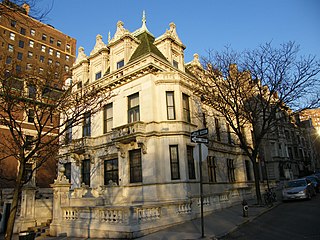
The Schinasi House is a 12,000-square-foot (1,100 m2), 35-room marble mansion located at 351 Riverside Drive on the Upper West Side of Manhattan in New York City. It was built in 1907 for Sephardic Jewish tobacco baron Morris Schinasi. The mansion was designed by Carnegie Hall architect William Tuthill and reportedly retains almost all of its historic detail, including a Prohibition-era trap door to a tunnel that once extended all the way to the river.

Betts House, also known as the John M. Davies House or Davies Mansion, is a mansion owned by Yale University in the Prospect Hill Historic District of New Haven, Connecticut. Completed in 1868 and designed by Henry Austin, it was sold to Yale in 1972 and is now home to the Yale Center for the Study of Globalization.
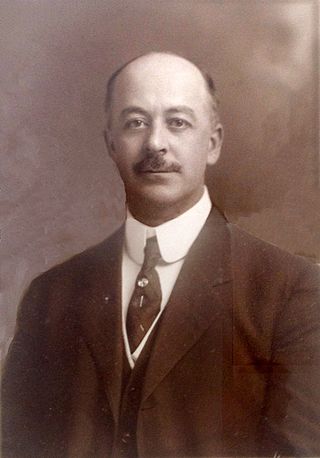
Archibald Johnston was a mechanical engineer who, favored by Bethlehem Iron Company management and senior Bethlehem Steel Company president Charles M. Schwab, became president of Bethlehem Steel Company. He was subsequently appointed as first vice president of the Bethlehem Steel Corporation in charge of foreign sales. While first vice president, he led a municipal consolidation campaign to create the modern city of Bethlehem, Pennsylvania, from the boroughs of Bethlehem and South Bethlehem.
Metallurgical Worker and Metallurgical Science are a duo set of 1903 bronze sculptures by Jean-Léon Gérôme. The pair of works commissioned from the artist by the steel magnate Charles M. Schwab to glorify to steel industry. Schwab paid for a steel worker to travel to Paris to sit for the sculptures. The works were displayed at the industry captain's 75 room mansion on Riverside Drive New York City until its demolition in 1947. Ge was introduced to Gérôme by Maurice Herbert, the French architect who designed his French Renaissance style home, once the largest in New York City.
